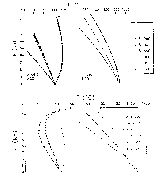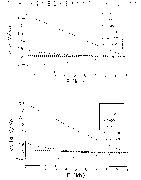
Volumetric Constraints on Transport of Granitic Magma
through the Crust
Martha L. Sykes

Volumetric Constraints on Transport of Granitic Magma
through the Crust
Martha L. Sykes
The profound effect of volatiles on the phase equlibria of granitic magmas was demonstrated in the pioneering experiments of Tuttle and Bowen (1958) on the system albite-ortholcase-Quartz-H2O. Subsequent experimental studies of many natural and synthetic systems under both H2O-saturated (fluid present) and under-saturated (fluid-absent) conditions have clearly delineated the effects of H2O and CO2 on most magma types. For silicic magma systems, geologic evidence suggests that fluid-absent conditions prevail (Clemens 1984; 1993) at least until the final stages of magma chamber evolution.
Although abundant field evidence exists for granitic pluton emplacement mechanisms, little evidence for magma transport mechanisms exists. Diapirism and elastic crack propagation are two of the most likely processes; several studies have attempted to constrain ascent velocities, temperature, and magma body size by applying appropriate fluid dynamics or heat transfer models. However, consequences of H2O and CO2 in silicic magmas during transport and ascent through the crust have been ignored in most fluid dynamic and heat transfer treatments of the problem. Instead, these models usually assume constant magma properties, and the volume of the system is also assumed to be constant. This article describes efforts to evaluate the assumption of constant volume during ascent of granitic magma using a model based on the albite-H2O and albite-H2O-CO2 systems.
The Model
A theoretical model based on phase equlibria of the system albite-H2O-CO2 (Sykes 1986; Sykes & Holloway 1987) provides the basis for magma ascent calculations. The proportion of volatile phase (H2O or H2O+CO2) dissolved in "magma" (albite melt + albite crystals) is calculated for a given pressure, total volatile content, and crystallization rate. Magma temperature is calculated iteratively using the free energy-activity relationships for the crystallization of albite from a hydrous melt. The model assumes that no interactions with CO2 produce mineral phases; CO2 solubility in the melt is limited, and the H2O-CO2 fluid mixed ideally (modified Redlich-Kwong equation of state). Only anhydrous crystalline phases are formed during ascent.
 Figures 1A and 1B. Ascent trajectories for fluid-absent and
fluid-present systems, respectively. In each, the group of curves at left is
for 8 wt% H2O, and those at right for 1 wt% H2O. Trajectory codes (boxes) are
as follows: M = wt% H2O in the system; N = wt% CO2 in the system; X = initial %
crystals in the system (either 0 or 60); Y = final % crystals (either 0 or
60).
Figures 1A and 1B. Ascent trajectories for fluid-absent and
fluid-present systems, respectively. In each, the group of curves at left is
for 8 wt% H2O, and those at right for 1 wt% H2O. Trajectory codes (boxes) are
as follows: M = wt% H2O in the system; N = wt% CO2 in the system; X = initial %
crystals in the system (either 0 or 60); Y = final % crystals (either 0 or
60).
Typical sets of pressure-temperature trajectories of the fluid-absent system albite-H2O with 1 and 8 wt% H2O in the melt and various crystallization rates are shown in Figure 1A. Trajectories terminate at the H2O-saturated albite solidus (H2O activity = 1). Temperatures are those of the albite system and thus higher than those of actual granitic systems. When CO2 and H2O are present, a fluid is present due to the low solubility of CO2 in the magma and the partitioning of H2O into the fluid phase. The presence of a fluid phase results in compositional changes of both the fluid and melt phases as a function of pressure and temperature. Figure 1B shows typical trajectories for systems with 1 and 8 wt% H2O (as for Fig. 1A) but with 1 wt% CO2 added. Magma trajectories calculated with evolved fluid lost during ascent closely resemble those of the fluid-absent albite H2O system.
Volume Change During Ascent
Magma properties such as volume can be calculated along ascent paths as a function of pressure, temperature, and magma composition. Magmatic volume is calculated for the system albite-H2O after Burnham and Davis (1971; 1974) as a function of moles of the albite and H2O component in the melt and crystalline phases. Fractional changes in magma volume over particular ascent trajectories with 1 wt% H2O and 0-1 wt% CO2 at various crystallization rates are shown in Figure 2A. The fluid-absent trajectories show little volume change during ascent, but fluid-present trajectories have up to three-fold increases in volume. For water-rich systems (8 wt% H2O; Figure 2B) the volume changes are proportionately higher as more water is dissolved in the melt or present in the fluid phase.
 Figures 2A and 2B. Fractional volume changes from initial
conditions, for fluid-absent and fluid-present systems, respectively. In A (1
wt% H2O): paths 1-600 and 1-1-600 have zero to negative volume changes: the
increasing amount of melt effectively decreases the mole fraction of H2O in the
melt. For fluid-present systems there are large (>200%) volume changes over
the ascent path. In B (8 wt% H2O): the volume increases are somewhat
greater.
Figures 2A and 2B. Fractional volume changes from initial
conditions, for fluid-absent and fluid-present systems, respectively. In A (1
wt% H2O): paths 1-600 and 1-1-600 have zero to negative volume changes: the
increasing amount of melt effectively decreases the mole fraction of H2O in the
melt. For fluid-present systems there are large (>200%) volume changes over
the ascent path. In B (8 wt% H2O): the volume increases are somewhat
greater.
The effect of these volume increases depends on the ascent mechanism and ascent velocity of the magma, and rheology of the crust over the ascent path. In regions of ductile crust, volume changes are accommodated by the crust, so that internal magma pressure remains approximately lithostatic. for a spherical diapir, the volume changes calculated in Figure 2A and B result in changes of diapir radii of -30 to +70%.
Consequences of Zero Volume Change During Ascent
In brittle crust, however, only a small fraction of magma volume increase can be accommodated by wall rock compressibility. Internal magma pressures greater than lithostatic can develop (the increased solubility of H2O in the magma due to higher internal pressure only partially compensates for the effect). When magma internal pressure exceeds lithostatic pressure by an amount equal to the tensile strength of the wall rocks, failure of the confining walls must occur.
The buildup of internal pressure during ascent of magma through rigid crust is calculated using a modified version of the magma ascent model described above. The excess of internal pressure over external (lithospheric) pressure is shown in Figure 3 for a number of different crystallization trajectories for the fluid-absent system albite-H2O. The rate at which internal pressure increases depends both on the initial water content of the magma and on the crystallization rate; high water content and fusion of pre-existing crystals enhance internal pressure buildup. In the absence of crystallization or fusion (trajectories 1-00 and 8-00) the excess internal pressure approaches or exceeds 100 bars within the first third of the ascent path.
Fluid-present systems undergo much greater volume increases than fluid-absent systems for the same crystallization rate, and hence have even more rapid increases of internal pressure over external pressure. Wall rock strength would be exceeded within a few kilometers of ascent for all cases.
The consequences of volume increases during ascent to current models of magma transport are several. During fluid-present ascent through brittle crust the great excess pressures generated result in shattering and fracturing of the surrounding wall rock and possible quenching of the magma. Fluid would be lost during this process; the resulting fluid-poor magma would have increased viscosity and density compared to the fluid-present case, and hence require higher temperatures for mobility. Further magma transport would depend on the presence of an additional magma source linked from below. For transport of magma by elastic crack propagation or other fracture flow mechanism, volume increases would promote crack propagation and hence speed the ascent of magma toward the surface. Non-equilibrium conditions could prevail during very rapid ascent, and this requires further evaluation.
 Figure 3. Changes in internal magma pressure for fluid-absent systems
during ascent, for various crystallization/fusion trajectories. When P
>~100 to 200 bars, rupture of wall rocks may occur. For low H2O
contents, no overpressures are generated for high crystallization (1-060),
however, for higher rates (1-030 & 1-00), overpressures of 50-100 bars are
reached. For higher H2O contents, minor overpressures are generated even for
high crystallization rates, and for no crystallization or fusion overpressures
of 100-200 bars are generated halfway to the surface.
Figure 3. Changes in internal magma pressure for fluid-absent systems
during ascent, for various crystallization/fusion trajectories. When P
>~100 to 200 bars, rupture of wall rocks may occur. For low H2O
contents, no overpressures are generated for high crystallization (1-060),
however, for higher rates (1-030 & 1-00), overpressures of 50-100 bars are
reached. For higher H2O contents, minor overpressures are generated even for
high crystallization rates, and for no crystallization or fusion overpressures
of 100-200 bars are generated halfway to the surface.
It is unlikely that fluid-rich magma can travel for any great distance through the crust as diapirs; diapiric ascent of such magma is limited to the deep crustal environment. However, for fluid-poor or fluid-absent magmas, their more gradual increases in internal pressure may be beneficial to magma transport through the crust by a combination of fracture propagation and stoping. During slow ascent, magma bodies can become compositionally zones. The volatile-rich cap zone of such a body would undergo most of the volume changes associated with the melt phase and infiltrating volatile-rich phases could hydrate the wall rock and reduce its melting temperature. Magma ascent would be facilitated by a combination of decreasing wall rock viscosity in the immediate vicinity of the magma body, and by encouraging stoping of wall rocks above the diapir.
At shallow crustal levels the volume changes associated with the volatile components of magma are great and eventually may result in a volcanic eruption. The presence of shallow level magma chambers beneath volcanic centers must result from repeated transport of magma from deeper levels. Further analysis of magma changes using the albite-H2O-CO2 model will give some insight into how such shallow level magma chambers come into existence and the factors which contribute to volcanic eruptions.
reprinted from the Hawaii Center for Volcanology Newsletter, Volume 2, Number 1, December 1994
 Hawaii Center for Volcanology Home Page
Hawaii Center for Volcanology Home Page
This page created and maintained by
Ken Rubin ©,
krubin@soest.hawaii.edu
Other
Last page update on 31 Jan 2002